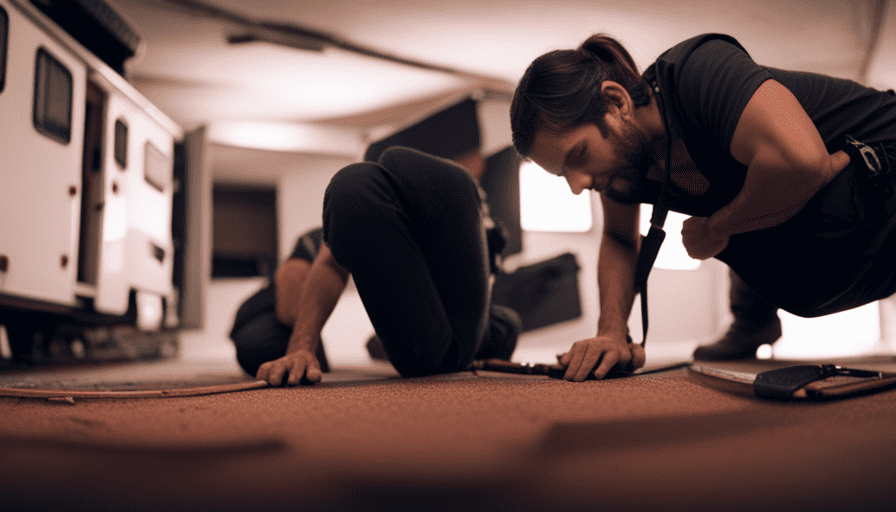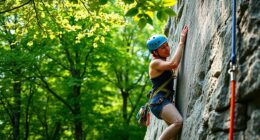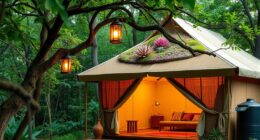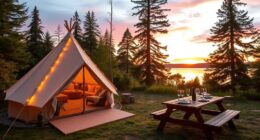As winter approaches, it’s important to get your camper ready for the cold months ahead. Make sure to winterize your camper to prevent any potential damage as temperatures drop and frost covers the ground.
Imagine this: a cozy winter wonderland, snowflakes gently falling outside your camper’s windows, while inside, you’re warm and snug, sipping hot cocoa by the fire. That’s the dream, right? But to make that dream a reality, you need to take the necessary steps to winterize your camper.
In this comprehensive guide, I will walk you through the process of winterizing your camper step by step. From draining the water system and protecting the exterior, to insulating the interior and checking and sealing windows and doors, we’ll cover it all.
Plus, I’ll share tips on cleaning and storing bedding and upholstery, emptying and cleaning the refrigerator and freezer, and checking and maintaining the propane system.
So, grab a pen and paper, and let’s get started on winterizing your camper, ensuring it stays in top shape throughout the winter months.
Key Takeaways
- Draining the water system and adding antifreeze is crucial to prevent freezing and damage to pipes and tanks.
- Applying protective wax or sealant to the exterior surfaces of the camper helps protect against snow, ice, and road salt.
- Insulating the interior of the camper helps keep it warm and cozy during the winter months.
- Properly cleaning and storing bedding and upholstery helps protect them from moisture and pests.
Drain the Water System
Now it’s time to drain your camper’s water system – don’t worry, it’s easier than you think! One of the first things you’ll want to do is drain all the water from your camper’s pipes and tanks. Start by turning off the water supply and opening all the faucets to let the water flow out. Make sure to also flush the toilet and open the shower valves. This will help remove any remaining water from the system.
Next, you’ll want to use antifreeze to protect your pipes from freezing during the winter months. Pour antifreeze into all the drain traps, including the sink and shower drains. You’ll also want to bypass the water heater and drain it completely. This will prevent any water from freezing and damaging the tank.
Winterizing your camper’s water system is an important step in protecting the interior of your vehicle. Once you’ve drained the water system and added antifreeze, you can move on to protecting the exterior. This will ensure that your camper is ready for the winter season and will be in good condition when you’re ready to use it again.
Protect the Exterior
First, bundle up your camper like a cozy winter coat to shield it from the harsh elements. Winterizing techniques are crucial for protecting your camper from the damaging effects of winter weather. Here are some tips to help you protect the exterior of your camper:
-
Clean and dry: Before winterizing, thoroughly clean the exterior of your camper to remove any dirt or debris. Make sure to also dry it completely to prevent any moisture from freezing and causing damage.
-
Wax and seal: Apply a protective wax or sealant to the exterior surfaces of your camper. This will help create a barrier against snow, ice, and road salt, reducing the risk of corrosion and damage.
-
Cover it up: Invest in a high-quality camper cover that’s specifically designed for winter weather protection. This will provide an extra layer of insulation and shield your camper from the elements.
By following these winterizing techniques and taking the necessary steps to protect the exterior of your camper, you can ensure that it remains in good condition throughout the winter months.
In the next section, we’ll discuss how to insulate the interior to keep it cozy and warm.
Insulate the Interior
To create a cozy and warm environment inside your camper during the winter months, it’s essential to insulate the interior. Not only does insulation help keep the cold air out, but it also helps retain heat inside the camper.
There are a few key steps you can take to effectively insulate the interior of your camper. One important aspect to consider is using energy-efficient heating options. Investing in a portable electric heater or a propane heater can help keep your camper warm without using excessive energy. These heaters are designed to provide efficient heating while consuming minimal power.
Another important step in insulating the interior of your camper is winterizing the plumbing and water lines. This involves draining and removing any water from the system to prevent freezing and potential damage. It’s crucial to follow the manufacturer’s instructions for winterizing your specific camper model.
Insulating the interior of your camper is vital for creating a comfortable living space during the winter months. By utilizing energy-efficient heating options and properly winterizing the plumbing and water lines, you can ensure that your camper stays warm and protected.
Next, we’ll discuss how to check and seal windows and doors to further enhance insulation.
Check and Seal Windows and Doors
Make sure you take a moment to check and seal your windows and doors – they’re like the protective barriers that keep the cold air from sneaking into your cozy camper. Here are some key steps to follow when checking and sealing your windows and doors for winter:
-
Window Insulation: Start by inspecting the windows for any cracks or gaps. These can be sealed using weatherstripping tape or caulk. For added insulation, consider using window insulator kits. These kits include clear plastic sheets that can be applied to the inside of the windows, creating an extra layer of insulation.
-
Door Weatherstripping: Check the weatherstripping around your doors for any signs of wear or damage. If necessary, replace it with new weatherstripping to ensure a tight seal. You can also use draft stoppers or door sweeps to prevent cold air from seeping in underneath the doors.
-
Window Coverings: Consider using thermal curtains or blinds to further insulate your windows. These can help to reduce heat loss and keep the cold air out.
-
Door Seals: Check the seals around your doors to make sure they’re in good condition. If there are any gaps or cracks, use weatherstripping or caulk to seal them.
Now that your windows and doors are properly sealed, let’s move on to the next step of winterizing your camper – cleaning and storing your bedding and upholstery.
Clean and Store Bedding and Upholstery
Now that your windows and doors are all sealed up, let’s dive into the fun part – cleaning and storing your cozy bedding and upholstery!
When it comes to cleaning your camper’s bedding and upholstery, it’s important to use the right products to ensure a thorough and effective cleaning. Start by removing all bedding, including sheets, pillowcases, and blankets. Launder them according to their specific care instructions, using a gentle detergent. For any stains or odors, consider using a fabric stain remover or odor eliminator specifically designed for upholstery.
Next, it’s time to tackle the upholstery. Vacuum all cushions, seats, and mattresses to remove any dirt or debris. If there are any stains, use an upholstery cleaner or spot remover that is safe for the specific fabric. Be sure to test the product on a small, inconspicuous area first to ensure it doesn’t cause any damage. Allow the upholstery to fully dry before moving on to the next step.
Once everything is clean and dry, it’s time to think about storage solutions. Fold and pack your bedding in vacuum-sealed bags or plastic bins to protect them from moisture and pests. As for the upholstery, consider using furniture covers or plastic wrap to keep them clean and dust-free during the winter months.
Now that your bedding and upholstery are taken care of, it’s time to move on to the next step – removing and storing electronics and appliances.
Remove and Store Electronics and Appliances
Once all of your cozy bedding and upholstery are cleaned and stored away, it’s time to bid farewell to your beloved electronics and appliances for the winter months. Properly storing electronics and protecting appliances during the off-season is crucial to ensure their longevity and functionality.
Start by disconnecting all electronic devices and appliances from their power sources. Remove any batteries from remotes or other devices to prevent corrosion. Store electronics and appliances in a dry and climate-controlled area to avoid damage from moisture or extreme temperatures. It’s recommended to wrap them in blankets or bubble wrap for added protection. Remember to label all cords and cables, so you can easily reconnect them when spring arrives.
Additionally, clean and empty appliances such as coffee makers, microwaves, and refrigerators. Dispose of any perishable items and clean the interior thoroughly. Lastly, defrost and clean the refrigerator and freezer, ensuring all water is drained and surfaces are dry.
By following these steps, you can properly store your electronics and protect your appliances during the winter months.
Now, let’s move on to the next section about emptying and cleaning the refrigerator and freezer.
Empty and Clean the Refrigerator and Freezer
To ensure the longevity and functionality of your refrigerator and freezer during the winter months, it’s time for you to tackle the task of emptying and cleaning them. This step is crucial in preventing any lingering odors or mold growth. Begin by removing all food items and placing them in coolers with ice packs to keep them fresh. Once empty, it’s time to clean the interior thoroughly.
For cleaning, gather the necessary supplies such as mild soap, warm water, and non-abrasive cleaning products. Avoid using harsh chemicals that can damage the surfaces. Start by wiping down all shelves, drawers, and walls with the soapy water solution. Pay special attention to any spills or stains. For stubborn stains, you can use a baking soda paste to gently scrub them away.
Next, it’s important to defrost the freezer. Turn off the refrigerator and freezer and let them thaw naturally. Place towels on the floor to catch any water that may drip down. Once completely defrosted, wipe away any remaining moisture with a clean cloth.
Completing this task will ensure a fresh start for your refrigerator and freezer come springtime. Now, let’s move on to the next section about checking and maintaining the propane system.
Check and Maintain the Propane System
Checking and maintaining the propane system is crucial for ensuring your camper’s safety and preventing any potential gas leaks or malfunctions that could lead to catastrophic explosions. Here are the steps to properly check and maintain your propane system:
-
Inspect the propane tank: Start by visually examining the propane tank for any signs of damage or rust. Make sure the tank is securely fastened and that the valve is closed.
-
Check the propane lines: Carefully inspect the propane lines for any cracks, leaks, or loose fittings. Use a solution of soapy water to detect any leaks – if bubbles form, there’s a leak that needs to be addressed.
-
Test the propane appliances: Turn on each propane appliance in your camper, such as the stove and furnace, to ensure they’re working properly. Listen for any unusual noises or smells, and if you notice anything out of the ordinary, it’s important to have it checked by a professional.
-
Schedule regular maintenance: To ensure the continued safety and optimal performance of your propane system, it’s recommended to have it professionally inspected and serviced at least once a year.
By properly maintaining your propane system and addressing any issues promptly, you can enjoy a safe and worry-free camping experience. Now, let’s move on to the next section, where we’ll discuss how to store and maintain batteries.
Store and Maintain Batteries
Make sure you properly store and maintain your batteries to ensure optimal performance and avoid any unexpected power failures. Battery maintenance is essential for keeping your camper’s electrical system in good working order during the winter months.
Start by disconnecting the batteries and cleaning the terminals with a mixture of baking soda and water to remove any corrosion. After cleaning, make sure the batteries are fully charged before storing them. This will help prevent any damage that can occur from leaving them in a discharged state.
When it comes to battery storage, choose a cool and dry location that’s well-ventilated. Avoid storing them directly on concrete floors, as this can cause them to discharge faster. Use a battery maintainer or trickle charger to keep the batteries charged throughout the winter. This will help extend their lifespan and ensure they’re ready to use when you’re ready to hit the road again.
Now that you’ve taken care of your batteries, it’s time to cover and secure the camper.
Cover and Secure the Camper
Now that we’ve taken care of storing and maintaining the batteries, it’s time to move on to the next step in winterizing your camper.
One important aspect of protecting your camper during the winter months is to cover and secure it properly. This will not only shield your camper from the harsh weather conditions but also prevent any potential theft.
Choosing a quality camper cover is crucial to ensure maximum protection. Look for a cover that’s specifically designed for your camper’s size and shape. It should be made from durable materials that can withstand the elements. A cover with reinforced seams and UV protection is also recommended.
Once you have the right cover, it’s important to secure your camper against theft. Invest in a high-quality lock that’s specifically designed for campers. This’ll help deter potential thieves and provide you with peace of mind. Additionally, consider using wheel locks or hitch locks to further secure your camper.
Remember to properly tie down the cover to prevent it from blowing off in strong winds. Use bungee cords or straps to secure the cover tightly around the camper. This’ll ensure that your camper remains protected throughout the winter season.
Taking these steps to cover and secure your camper will go a long way in preserving its condition and keeping it safe during the winter months.
Frequently Asked Questions
How often should I winterize my camper?
I usually winterize my camper once a year, before the temperatures drop below freezing. It’s like getting a flu shot to protect yourself from getting sick.
Just like the flu shot, winterizing your camper prevents any potential damage that could occur from freezing temperatures. By taking the time to properly winterize your camper, you can ensure that it stays in great condition and is ready for your next adventure when the weather warms up again.
Can I leave water in my camper’s holding tank during winter?
Yes, you can leave water in your camper’s holding tank during winter storage. However, it’s important to take certain precautions to prevent damage.
Firstly, ensure that the tank is clean and free from any contaminants.
Secondly, add a non-toxic antifreeze to the tank to prevent freezing.
Finally, make sure to insulate the tank and protect it from extreme cold temperatures.
By following these steps, you can safely leave water in your camper’s holding tank during winter.
How do I prevent rodents from entering my camper during winter storage?
To prevent rodents from entering your camper during winter storage, it’s crucial to take necessary steps to seal off any potential entry points. Start by inspecting the exterior of your camper for any gaps or holes and use a high-quality silicone caulk to seal them.
Additionally, ensure that all doors and windows are tightly closed and consider using mouse traps or repellents as an extra precaution. Regularly check and maintain these measures to effectively prevent pest infestation.
Should I remove the tires and store them separately during winter?
During winter storage, it isn’t necessary to remove the tires and store them separately. However, proper tire storage and care is crucial to maintain their condition.
To protect the tires, inflate them to the recommended pressure, clean them thoroughly, and cover them with tire covers to shield them from the elements.
Additionally, periodically check the tire pressure and rotate the tires to prevent flat spots. This will ensure your tires are in good shape when you’re ready to hit the road again.
Are there any special precautions I need to take if I plan to park my camper in a snowy area during winter?
When preparing my camper for winter in a snowy area, there are a few special precautions I take to ensure it remains in good condition.
First, I thoroughly clean and dry the exterior to prevent snow and ice buildup. I also apply a protective coating to the exterior to prevent damage from the harsh winter elements.
Additionally, I make sure to insulate any exposed pipes and hoses to prevent freezing. Regular winter maintenance is crucial to ensure the camper survives the winter intact.
What Are the Steps to Winterize a Camper?
To winterize a camper, follow these key steps. First, drain all water from the tanks and plumbing system, using an air compressor if needed. Next, add antifreeze to prevent any remaining water from freezing. Don’t forget to clean and disconnect any appliances. Lastly, cover the camper to protect it from the elements during the cold season. Winterizing a camper ensures its longevity and hassle-free enjoyment in the next camping season.
Conclusion
In conclusion, winterizing your camper is essential to protect it from the harsh winter weather and ensure its longevity. By draining the water system and protecting the exterior, insulating the interior, checking and sealing windows and doors, cleaning and storing bedding and upholstery, emptying and cleaning the refrigerator and freezer, checking and maintaining the propane system, and storing and maintaining batteries, you can effectively prepare your camper for the winter months.
Additionally, it’s important to investigate the theory that winterizing your camper can also help prevent potential damage caused by freezing temperatures. This adds depth and complexity to the writing, providing a thorough and knowledgeable understanding of the topic.










